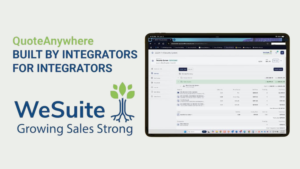How Do We Know If We’re Really Making Money? Thinking Strategically About Profitable Growth
Panelists John Palumbo (President, UTI Global), Michael Ruddo (Chief Strategy Officer, Integrated Security Technologies, Inc.), John Nemerofsky (COO, SAGE Integration), and Isac Tabib (VP, ITG) are each tasked with identifying and implementing strategies and workflows to meet their company’s specific goals for profitability and growth. Here’s some advice they shared about growing their organizations in today’s volatile business climate.

By Tracy Larson
At the recent PSA TEC 2022, I was fortunate to moderate a panel featuring leaders from four highly successful security systems integrators to chat about the all-important question, “How Do We Know if We’re Really Making Money?”
Panelists John Palumbo (President, UTI Global), Michael Ruddo (Chief Strategy Officer, Integrated Security Technologies, Inc.), John Nemerofsky (COO, SAGE Integration), and Isac Tabib (VP, ITG) are each tasked with identifying and implementing strategies and workflows to meet their company’s specific goals for profitability and growth. Their insights knocked it out of the park!
Here’s some advice they shared about growing their organizations in today’s volatile business climate.
Establish a solid business technology foundation.
The panelists each hold different titles and bear different responsibilities, but all agree that business technology drives efficiencies at their respective companies. They use it to define repeatable processes and to centralize and use data, which are particularly important in growth and profitability – especially when companies merge. Established systems help employees move beyond their comfort zones, changing how they do things to be consistent with the organization.
John N. shared that when SAGE was founded as a product of two separate successful system integrators, it was imperative to get everyone working in a shared sales software platform. It ensured consistency throughout the organization and provided data to establish and evaluate KPIs that would drive the new company’s growth.
Mike stressed that the data made available through technology platforms allow management at IST to determine true profitability rather than just operating based on gut feelings. It opens their eyes to what’s really going on.
Sales accuracy REALLY matters.
If a company can’t get the precision it needs in sales, it will be very hard to compensate for those losses on the delivery end. Isac explained that at ITG, sales accuracy starts with a strong culture that relies on a consistent way of estimating. When estimating processes are in place, it lowers risk as projects move into the delivery phase.
At SAGE, one thing the company did to ensure accuracy was to require engineering review of all quotes before they leave the building. Until sign-off occurs, quotes feature a large watermark indicating their unapproved status. Salespeople would never consider sharing those with a customer. Sales management software makes this process easy to implement. Since automating mandatory engineering reviews, the company has quoted about $60 million in projects and closed out 5% higher than their estimated profit. Amazing!
A theme expressed by all panel members was how much they value the ability of software to keep pricing current, especially in today’s economy, where inflation requires constant updates. Software also ensures that quoted labor is fully burdened making estimates much more accurate. Pricing accounts not only for a technician’s hourly rate, but their benefits, the truck, the laptop, tools, and everything else needed to deliver services.
John P noted that quoting across various markets or project types requires different estimate templates: union environments, construction projects, and corporate opportunities each impact pricing differently. If quoting isn’t handled accurately, it’s easy to lose profitability.
Finally, Isac shared a perceptive insight. He said, “We all think that as security integrators, we’re in the business of selling security. Actually, we’re in the business of risk management. We want to eliminate the opportunity to do things that can have a negative financial impact on our business while, at the same time, we want to increase output. When quotes are inaccurate, we increase the risk that projects will be unprofitable upon delivery.”
Centralized real-time data drives profitability.
Companies have no control when data is floating around on various laptops or kept on so many different drives on the server. They don’t know what information exists, whether it is accurate, and how it relates to data elsewhere. There is also the risk of it falling into the wrong hands or leaving the company with a departing employee. A centralized database is the only way for companies to maintain possession of their customer and parts data and ensure that they are consistently updated across the board, ideally, in real-time.
Centralized data also makes detailed analysis possible. At IST, management evaluates historical trends to understand actual expenses versus selling rates. Labor category trends have shown that within its diversified client base, some sectors are more profitable than others. With that knowledge, the company strategically focuses more resources on targeting specific verticals. Similarly, at UTI, they carefully evaluate data trends to determine which managed services and RMR solutions continue to generate the most revenue over time. Those that don’t measure up get dropped. These are just a few of the many examples that the panelists shared.
Automation smooths project delivery.
Using technology to automate processes keeps operations on the right track as your business grows. It ensures uniformity and consistency. For example, if you have three different techs and each does things their own way, it’s tough to manage what’s going on in the field. Now imagine what happens if you have 20 techs! When nobody knows what to expect from project to project, there will be a lot of wasted time, effort, and dissatisfied customers.
Part of maintaining consistency is carefully choosing which manufacturers to partner with. All panelists stressed how carefully their organizations consider bringing in new product lines. Isac noted that committing to new lines requires at least a half a million dollars investment by the organization. However, once that decision is made, having the right technology in place makes it much easier to include new offerings, and then properly install and deploy them.
Prioritize attracting, developing, and retaining great people.
It’s harder than ever to hire qualified workers. Integrators are finding that they must do more to attract the best candidates and keep them motivated.
John N. suggested that the security industry, as a whole, must starting using updated terminology – i.e., recruiting “system engineers” instead of “technicians – and institute policies that demonstrate a commitment to inclusivity, flexibility, and employee empowerment.
Isac believes that the key to employee retention is providing value to employees’ lives. It isn’t just a matter of salary or bonuses. It’s making them feel understood and valued as individuals. Public recognition goes a long way, as well as private compliments and commendations for jobs exceptionally well done. When he sees an employee struggling, he communicates concern and pitches in – like paying for a worker’s dental surgery or their kid’s summer camp. These employees feel “seen” and appreciated. They’re not going to look for a job elsewhere.
All panelists agree that friendly competition and regular awards keep teams motivated. Project Manager of the Year, Service Tech of the Year, Rookie of the Year, and MVP of the Year, and recognition for hitting sales milestones or delivering big projects are examples of how companies can recognize employees within different departments and at different levels.
Wrapping Things Up
The PSA TEC panelists shared so much more, but I’ll sum it up this way. “How Do We Know if We’re Really Making Money?” boils down to four things that every company must have:
- Time is money so, efficient, repeatable, accurate processes.
- KPIs to define success. Data to measure those KPIs.
- Technology to gather and make sense of the data.
- Most importantly, an excellent team of people to make it all happen.
Recent Post

WeSuite Expands Its QuoteAnywhere to a Full-Featured Stand-Alone Sales Platform
WeSuite, a manufacturer of award-winning sales management software for security technology sales and service providers, is excited to announce the expansion of its web-based sales software, QuoteAnywhere, to a full-featured, stand-alone, lead-to-close sales platform.

WeSuite President Tracy Larson Inducted into Security Sales & Integrations Industry Hall of Fame
WeSuite, a manufacturer of award-winning sales management software for security technology sales and service providers, announced today that Tracy Larson, WeSuite President and Co-Founder, has been inducted into the Security Sales & Integration’s Industry Hall of Fame.

Are You Getting the Most Out of Your CRM? Start by Asking these 5 Simple Questions
Your sales pipeline is your lifeline. It tells you where your deals stand, where your time should go, and how close you are to hitting your number. And your CRM? It’s the tool that keeps your pipeline in check.

Is There a Secret to Closing Security Sales Faster? Here Are Seven!
Pushy, high-pressure sales tactics turn off buyers – we’ve all been there! Fortunately, you can increase your on-the-spot close ratio by being buyer and solution oriented with sales automation software like QuoteAnywhere from WeSuite to support your sales efforts.
